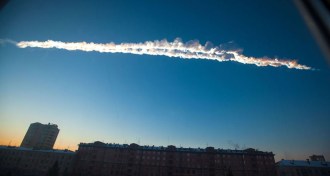Space
Sign up for our newsletter
We summarize the week's scientific breakthroughs every Thursday.
-

-
 Physics
PhysicsCosmic ray detector confirms hints of dark matter
Space station-based instrument records high amount of antimatter seen in earlier experiments.
By Andrew Grant -
 Physics
PhysicsUniverse is a teeny bit older than thought
Planck satellite reveals information from just after the Big Bang, largely confirming scientists' theories.
By Andrew Grant -
 Planetary Science
Planetary ScienceDistant planets’ atmospheres revealed
Telescopes get first direct glimpse of gases on exoplanets.
By Erin Wayman -
 Planetary Science
Planetary ScienceLife-friendly environment confirmed on Mars
Drill sample from bedrock reveals chemistry that could have supported microbial life.
By Andrew Grant -

-
 Space
SpaceNo vacancy around stars
The Milky Way’s planets pack tightly around their stars, according to simulations using data from the Kepler space telescope.
By Andrew Grant -
 Space
SpaceRadiation ring around Earth mysteriously appears, then dissipates
Space probes detect temporary transition from two radiation belts to three, possibly in response to solar activity.
-
 Space
SpaceNew home for runaway black hole
Galactic merger and ejection may have sent a cosmic wanderer through deep space.
By Andrew Grant -
 Space
SpaceSmallest planet found orbiting distant star
NASA’s Kepler space telescope snags an exoplanet tinier than Mercury.
By Andrew Grant -
 Astronomy
AstronomyRussia meteor virtually impossible to see coming
Current and planned efforts to track near-Earth objects focus on bigger quarry.
By Andrew Grant -
 Planetary Science
Planetary ScienceMeteor explodes over Russia
The object is unrelated to February 15 asteroid flyby, experts say.
By Andrew Grant